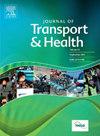Built environment and active commuting to school: the moderating effects of psychosocial factors and neighborhood safety in girls and boys
IF 3.3
3区 工程技术
Q2 PUBLIC, ENVIRONMENTAL & OCCUPATIONAL HEALTH
引用次数: 0
Abstract
Introduction
There are mixed findings on the relation between built environment attributes and active commuting to and from school (ACS). In addition to methodological differences in assessing the built environment, some of these mixed findings may be due to moderating variables in the associations between built environment and ACS. Hence, the present study aimed to analyze whether the perception of psychosocial variables and neighborhood safety moderated associations between built environment attributes and ACS among female and male adolescents.
Methods
This cross-sectional study was conducted in Valencia, Spain, among 465 adolescents (aged 14–18 years). Built environment attributes of the home neighborhood were evaluated using geographic information system data. Socio-demographic characteristics, psychosocial factors, neighborhood perceived safety, and ACS were self-reported by adolescents using validated scales. Mixed effects regression models were used to estimate associations. The analyses were carried out separately in girls and boys.
Results
The strongest associations of residential density, public transportation density, and greenspace area with ACS were found among those adolescents with the highest level of decisional balance, social support from siblings/peers, and safety related to pedestrian infrastructure. However, there were substantial sex differences found in patterns of moderation.
Conclusions
Present findings support the ecological model principle of interactions across levels of influence when analyzing ACS correlates in adolescents. These findings suggest multilevel interventions may be needed to promote ACS, and the different needs of girls and boys should be considered.
建成环境和主动上学:心理社会因素和社区安全对男孩和女孩的调节作用
关于建筑环境属性与主动往返学校(ACS)之间的关系,研究结果喜忧参半。除了评估建筑环境的方法差异外,这些混合结果中的一些可能是由于建筑环境与ACS之间关联的调节变量。因此,本研究旨在分析社会心理变量感知和邻里安全是否调节了男女青少年建筑环境属性与ACS之间的关联。方法本横断面研究在西班牙瓦伦西亚进行,共纳入465名青少年(14-18岁)。利用地理信息系统数据对住宅小区的建成环境属性进行评价。社会人口学特征、社会心理因素、邻里安全感和ACS由青少年使用有效的量表自我报告。混合效应回归模型用于估计相关性。这些分析是在女孩和男孩中分别进行的。结果居住密度、公共交通密度和绿地面积与ACS的相关性在决策平衡、兄弟姐妹/同伴社会支持和行人基础设施安全水平最高的青少年中最强。然而,在适度饮酒的模式上却存在着巨大的性别差异。结论在分析青少年ACS相关因素时,本研究结果支持跨影响水平相互作用的生态模型原理。这些发现表明,促进ACS可能需要多层次的干预措施,并应考虑女孩和男孩的不同需求。
本文章由计算机程序翻译,如有差异,请以英文原文为准。
求助全文
约1分钟内获得全文
求助全文

 求助内容:
求助内容: 应助结果提醒方式:
应助结果提醒方式:


